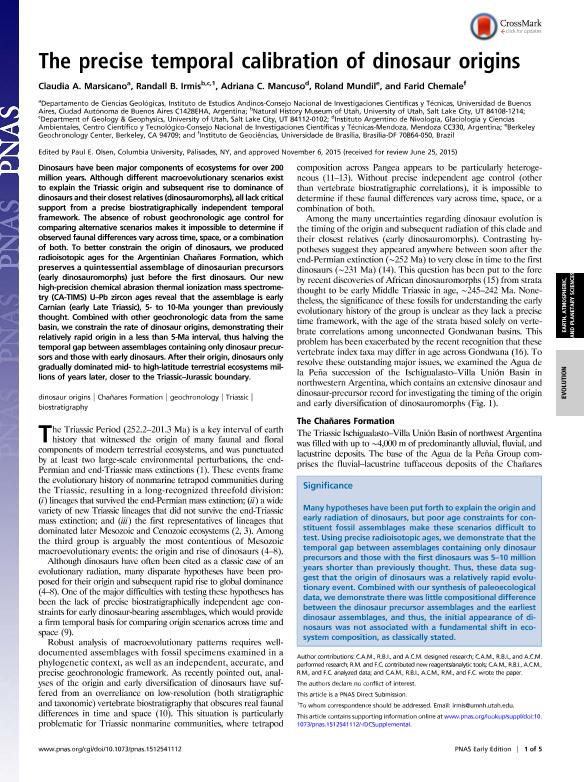Mostrar el registro sencillo del ítem
dc.contributor.author
Marsicano, Claudia Alicia

dc.contributor.author
Irmis, Randall
dc.contributor.author
Mancuso, Adriana Cecilia

dc.contributor.author
Mundil, Roland
dc.contributor.author
Chemale, Farid

dc.date.available
2019-09-30T18:56:05Z
dc.date.issued
2016-01
dc.identifier.citation
Marsicano, Claudia Alicia; Irmis, Randall; Mancuso, Adriana Cecilia; Mundil, Roland; Chemale, Farid; The precise temporal calibration of dinosaur origins; National Academy of Sciences; Proceedings of the National Academy of Sciences of The United States of America; 113; 3; 1-2016; 509-513
dc.identifier.issn
0027-8424
dc.identifier.uri
http://hdl.handle.net/11336/84832
dc.description.abstract
Dinosaurs have been major components of ecosystems for over 200 million years. Although different macroevolutionary scenarios exist to explain the Triassic origin and subsequent rise to dominance of dinosaurs and their closest relatives (dinosauromorphs), all lack critical support from a precise biostratigraphically independent temporal framework. The absence of robust geochronologic age control for comparing alternative scenarios makes it impossible to determine if observed faunal differences vary across time, space, or a combination of both. To better constrain the origin of dinosaurs, we produced radioisotopic ages for the Argentinian Chañares Formation, which preserves a quintessential assemblage of dinosaurian precursors (early dinosauromorphs) just before the first dinosaurs. Our new high-precision chemical abrasion thermal ionization mass spectrometry (CA-TIMS) U-Pb zircon ages reveal that the assemblage is early Carnian (early Late Triassic), 5- to 10-Ma younger than previously thought. Combined with other geochronologic data from the same basin, we constrain the rate of dinosaur origins, demonstrating their relatively rapid origin in a less than 5-Ma interval, thus halving the temporal gap between assemblages containing only dinosaur precursors and those with early dinosaurs. After their origin, dinosaurs only gradually dominated mid- to high-latitude terrestrial ecosystems millions of years later, closer to the Triassic-Jurassic boundary.
dc.format
application/pdf
dc.language.iso
eng
dc.publisher
National Academy of Sciences

dc.rights
info:eu-repo/semantics/openAccess
dc.rights.uri
https://creativecommons.org/licenses/by-nc-sa/2.5/ar/
dc.subject
BIOSTRATIGRAPHY
dc.subject
CHAÑARES FORMATION
dc.subject
DINOSAUR ORIGINS
dc.subject
GEOCHRONOLOGY
dc.subject
TRIASSIC
dc.subject.classification
Geología

dc.subject.classification
Ciencias de la Tierra y relacionadas con el Medio Ambiente

dc.subject.classification
CIENCIAS NATURALES Y EXACTAS

dc.title
The precise temporal calibration of dinosaur origins
dc.type
info:eu-repo/semantics/article
dc.type
info:ar-repo/semantics/artículo
dc.type
info:eu-repo/semantics/publishedVersion
dc.date.updated
2019-09-20T13:43:08Z
dc.journal.volume
113
dc.journal.number
3
dc.journal.pagination
509-513
dc.journal.pais
Estados Unidos

dc.journal.ciudad
Washington
dc.description.fil
Fil: Marsicano, Claudia Alicia. Consejo Nacional de Investigaciones Científicas y Técnicas. Oficina de Coordinación Administrativa Ciudad Universitaria. Instituto de Estudios Andinos "Don Pablo Groeber". Universidad de Buenos Aires. Facultad de Ciencias Exactas y Naturales. Instituto de Estudios Andinos "Don Pablo Groeber"; Argentina
dc.description.fil
Fil: Irmis, Randall. University of Utah; Estados Unidos
dc.description.fil
Fil: Mancuso, Adriana Cecilia. Consejo Nacional de Investigaciones Científicas y Técnicas. Centro Científico Tecnológico Conicet - Mendoza. Instituto Argentino de Nivología, Glaciología y Ciencias Ambientales. Provincia de Mendoza. Instituto Argentino de Nivología, Glaciología y Ciencias Ambientales. Universidad Nacional de Cuyo. Instituto Argentino de Nivología, Glaciología y Ciencias Ambientales; Argentina
dc.description.fil
Fil: Mundil, Roland. Berkeley Geochronology Center; Estados Unidos
dc.description.fil
Fil: Chemale, Farid. Universidade do Brasília; Brasil
dc.journal.title
Proceedings of the National Academy of Sciences of The United States of America

dc.relation.alternativeid
info:eu-repo/semantics/altIdentifier/doi/http://dx.doi.org/10.1073/pnas.1512541112
dc.relation.alternativeid
info:eu-repo/semantics/altIdentifier/url/https://www.pnas.org/content/113/3/509
Archivos asociados
